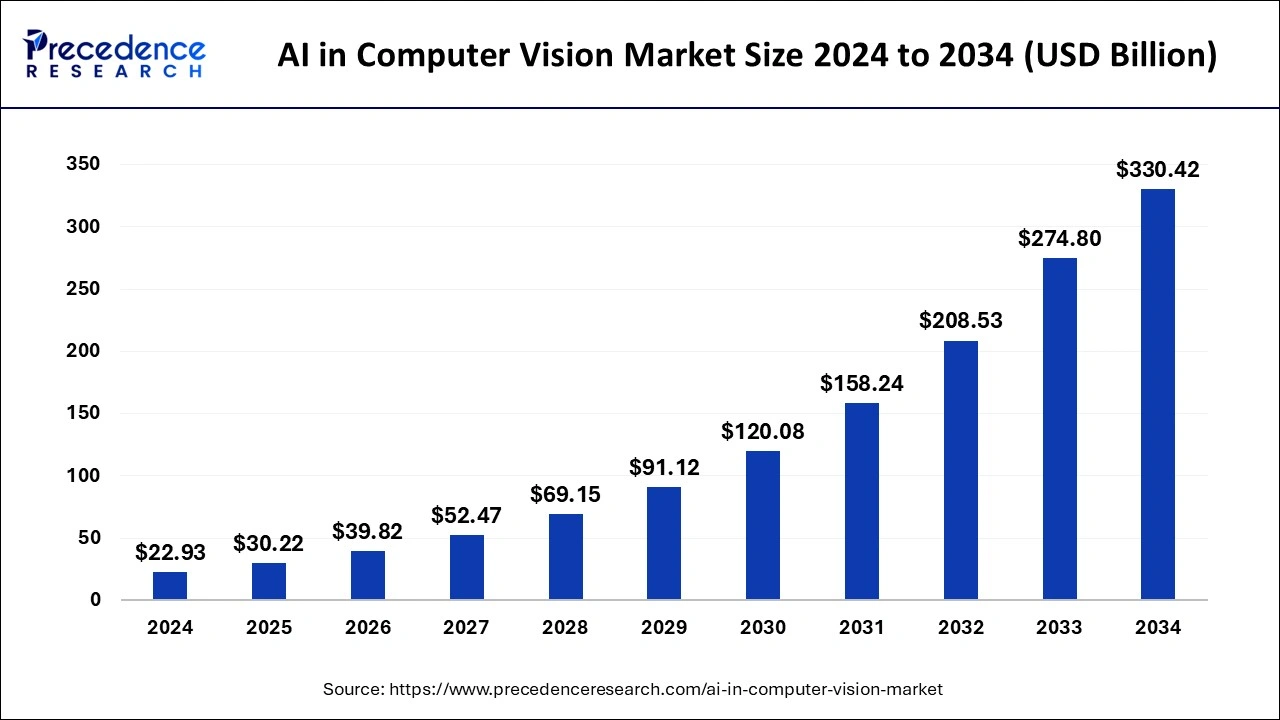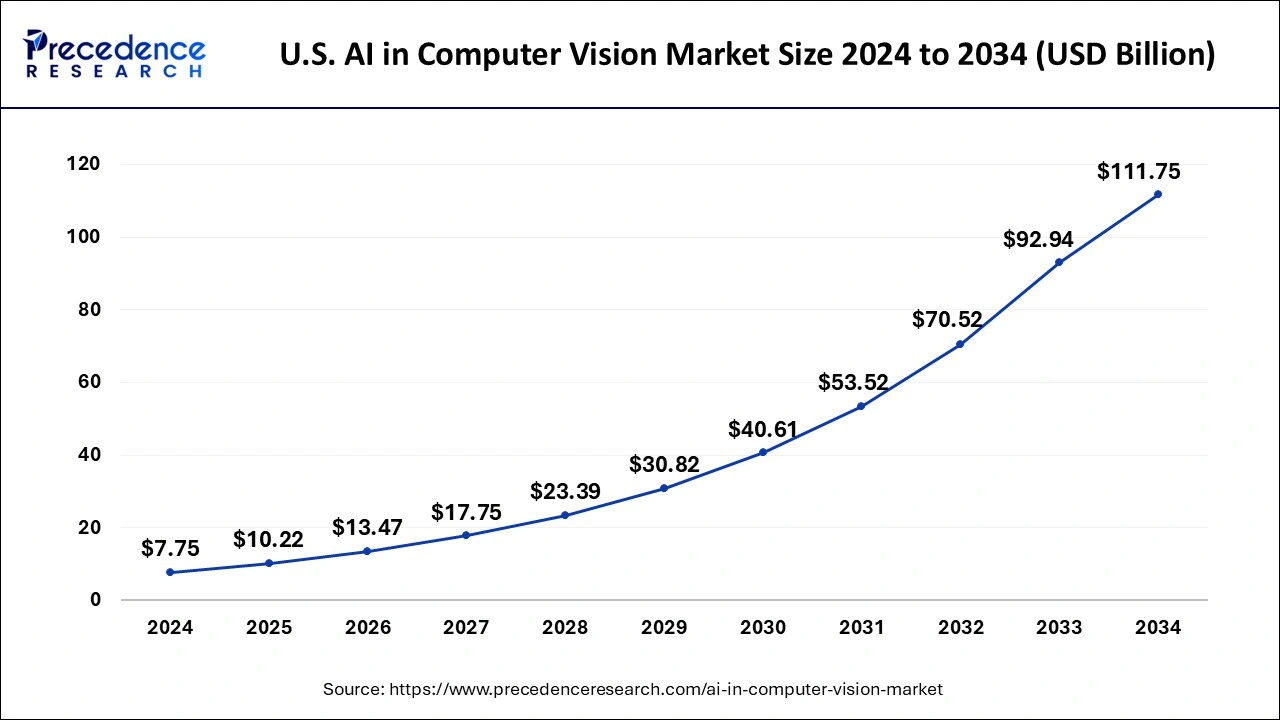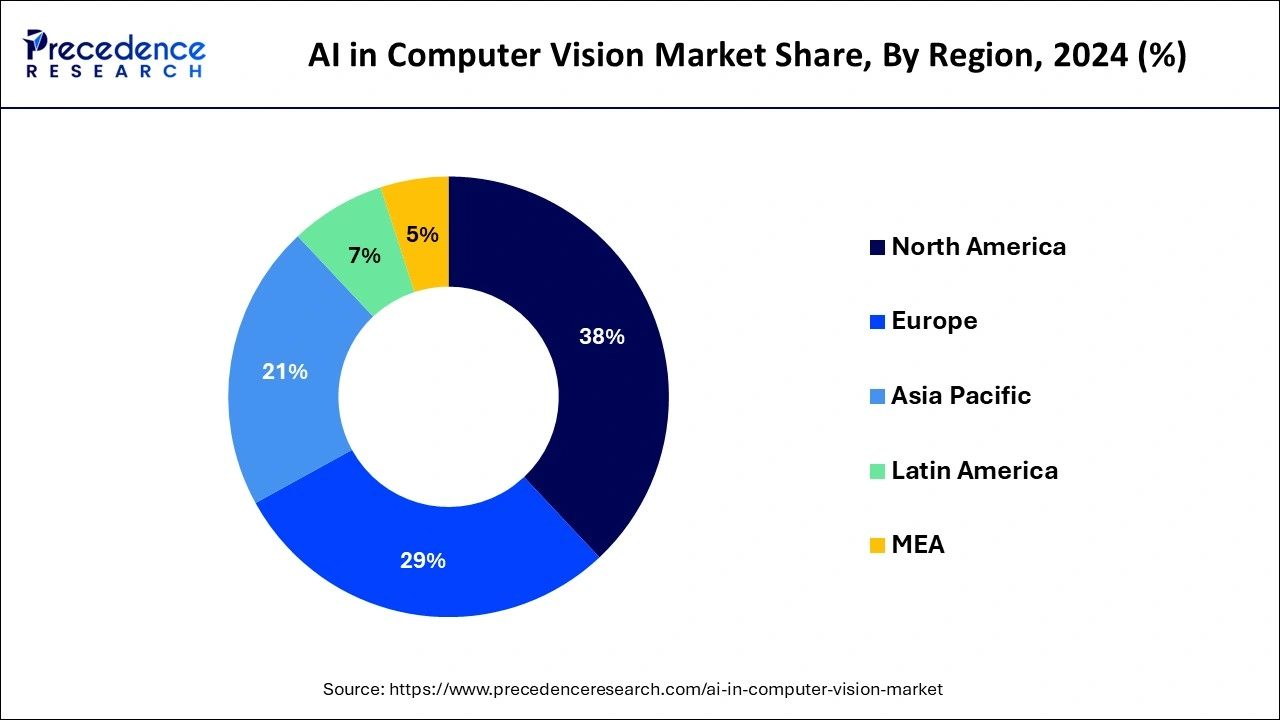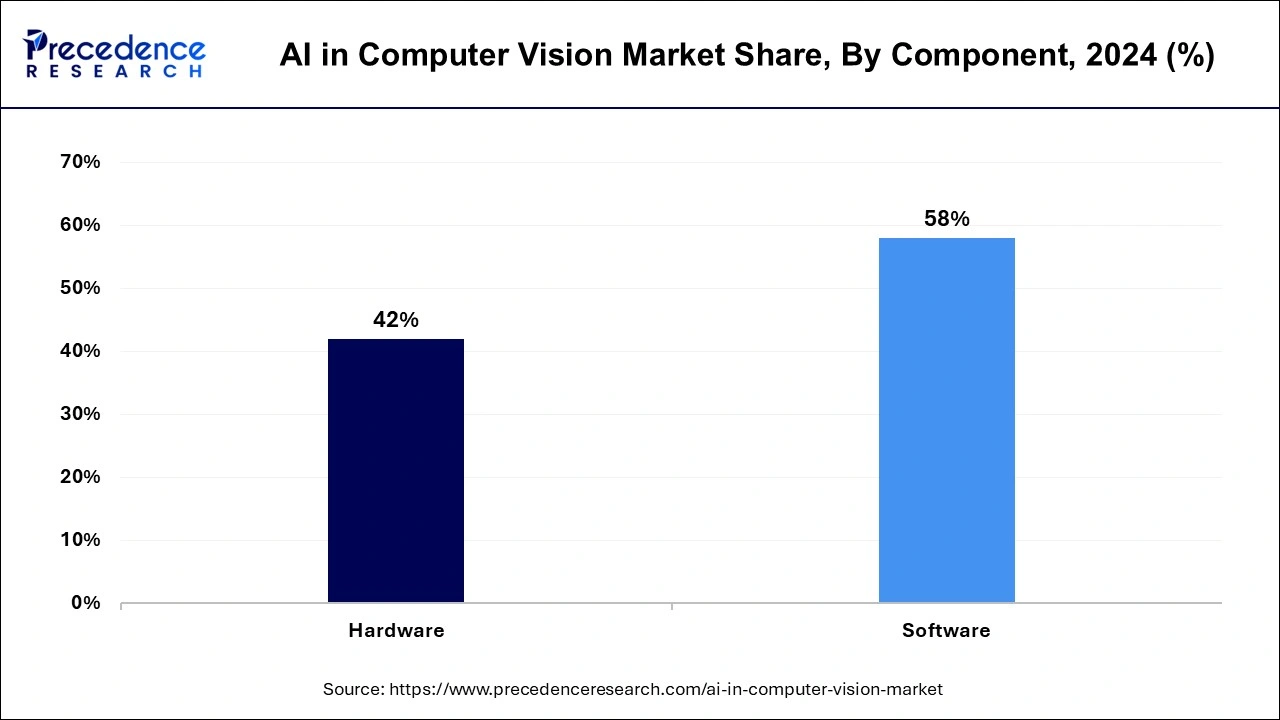July 2024
The global AI in computer vision market size is calculated at USD 30.22 billion in 2025 and is forecasted to reach around USD 330.42 billion by 2034, accelerating at a CAGR of 30.58% from 2025 to 2034. The North America AI in computer vision market size surpassed USD 8.71 billion in 2024 and is expanding at a CAGR of 30.59% during the forecast period. The market sizing and forecasts are revenue-based (USD Million/Billion), with 2024 as the base year.
The global AI in computer vision market size was estimated at USD 22.93 billion in 2024 and is predicted to increase from USD 30.22 billion in 2025 to approximately USD 330.42 billion by 2034, expanding at a CAGR of 30.58% from 2025 to 2034. Increasing demand for automation with AI assistance in various industries propelling market growth.

The U.S. AI in computer vision market size was valued at USD 7.75 billion in 2024 and is anticipated to reach around USD 111.75 billion by 2034, poised to grow at a CAGR of 30.60% from 2025 to 2034.

North America held the largest share of AI in the computer vision market in 2024. This dominance in the global market is owed to the presence of leading global market players in the North American region. Increased investments in research and development to establish cutting-edge technologies due to the growing demand for intelligent automation technologies are set to hold its leading position in the forecast period continuously. Rapid-growing innovations in the healthcare sector with AI-based solutions are also among the leading factors that dominate the market in North America.

Asia Pacific is the fastest-growing region in the global AI in computer vision market. During the forecast period, the region is expected to witness a considerable expansion rate, specifically in countries like China, India, and Japan. The region is witnessing huge investments in developing AI-based solutions owing to the engagement of tech giants in the research and development areas. Artificial intelligence-based solutions are incorporated by many sectors in the Asian Pacific region, such as manufacturing and automotive. Healthcare firms mostly use them as it has a wide range of applications for AI. Smart automation solutions are rapidly adopted in these sectors, propelling growth in the market.
Computer vision is a subfield of artificial intelligence (AI). It has seen significant advancements in recent years. It involves the development of algorithms and systems that enable computers to analyze and understand visual data, such as images and videos. With the proliferation of image and video data in various industries, computer vision has emerged as a crucial technology with numerous applications. One of the primary reasons behind the growth of AI in computer vision is the increasing demand for automation and efficiency across industries.
Computer vision technology presents significant opportunities for improving safety and security measures. For instance, surveillance systems equipped with computer vision algorithms can automatically detect and respond to security threats, such as unauthorized access or suspicious activities. This can be applied in various settings, including airports, public spaces, and critical infrastructure facilities.
The AI in computer vision market offers services that can automate various tasks that were previously performed manually, leading to significant time and cost savings. For instance, in manufacturing, computer vision can be used to inspect products for defects, which in turn reduces the need for human intervention. Similarly, in the retail sector, computer vision technology enables cashier-less systems, which is helpful in enhancing the shopping experience for customers and improving overall efficiency for retailers.
| Report Coverage | Details |
| Growth Rate from 2025 to 2034 | CAGR of 30.58% |
| Market Size in 2025 | USD 30.22 Billion |
| Market Size by 2034 | USD 330.42 Billion |
| Base Year | 2024 |
| Forecast Period | 2025 to 2034 |
| Segments Covered | By Component, By Application, By Function, and By End-use |
| Regions Covered | North America, Europe, Asia-Pacific, Latin America, and Middle East & Africa |
Deep learning and neural networks
Advancements in deep learning techniques, such as convolutional neural networks (CNNs), have revolutionized the field of computer vision. CNNs have demonstrated remarkable performance in tasks such as image classification, object detection, and semantic segmentation. These algorithms have greatly improved the accuracy and reliability of computer vision systems, making them more practical and effective than ever before.
The availability of powerful computing hardware and large datasets have been instrumental in training complex deep learning models, further driving the progress of the AI in computer vision market worldwide.
Data availability and quality
Computer vision algorithms rely heavily on high-quality annotated data for training and validation. However, acquiring such datasets can be challenging, particularly for niche or specialized applications. Additionally, manual explanations of datasets can be time-consuming and hectic.
The lack of diverse and representative datasets can limit the performance and generalized ability of computer vision systems. Data quality also poses a challenge, as incorrect or biased explanations can result in flawed AI models. Efforts should be made to address these challenges, including the development of synthetic datasets and techniques for data augmentation, but further advancements are needed to ensure access to diverse and reliable data sources. Thereby, the data availability and quality issues are observed to create a major restraint for the AI in computer vision market.
Augmented reality and virtual reality
Computer vision is crucial in enabling augmented reality and virtual reality experiences. AR technologies overlay digital information onto the user's real-world view, while VR immerses users in entirely virtual environments. Computer vision allows for real-time tracking of the user's position and movement, enabling seamless integration of virtual objects into the real world. This creates various opportunities in gaming, entertainment, training simulations, and various other industries. Companies like Apple, Google, and Microsoft are investing heavily in AR and VR technologies, driving innovation and creating new prospects for the AI in computer vision market.
The software segment held the largest share of 58% in 2024 the AI in the computer vision market. Several sectors like healthcare, retail, and automotive are incorporating deep learning algorithms and computer vision software. Due to the surge in such software, this segment of the AI in computer vision market is exponentially growing and dominating the market on a global scale. Specialized computer vision software is needed to accomplish certain requirements of the corporate field, which is increasing the software demand in the market.

AI-based computer vision systems are used in the healthcare sector for medical imaging, diagnosis of various diseases, and medication discovery. Computer vision systems are finely utilized in the retail sector to improve customer services and management of inventories with product recommendations to consumers.
The AI in the computer vision market is segmented into training and interference. Among these two, the training function dominated the AI in computer vision market in 2024. The availability of precise training data is necessary due to the rising demand for computer vision app locations facilitated by AI in the market. The advancement in deep learning algorithms requires specific training to achieve optimal outcomes. Hence, major tech companies are investing in creating efficient training datasets to improve their computer vision models in terms of accuracy and performance.
The nonindustrial segment held the largest market share in 2024. Retailers are adopting computer vision technology to enhance customer experiences, optimize inventory management, and streamline operations. AI-powered visual search, product recommendation systems, cashierless checkout, and inventory tracking solutions are revolutionizing the retail industry and driving business growth. The entertainment and media sector is utilizing computer vision technology for content creation, video analysis, virtual reality (VR), and personalized content delivery. AI algorithms enable content creators to automate video editing tasks, analyze audience engagement, and deliver immersive experiences to consumers.
The industrial segment is a notable segment of the market. Several industries like healthcare, manufacturing, and automotive are rapidly adopting AI-based technologies to enhance their efficiency and production rate. This factor is attributed to the growth of the industrial segment, which in turn fuels AI in the computer vision market. Computer vision assists industrial processes with automated inspection without human interference, fault detection in machines, real-time monitoring, etc., which helps in cost savings and improves productivity. The industrial segment has recognized the potential of AI in computer vision, which drives the industrial segments and, thus, AI in the computer vision market on a global level.
The consumer electronic segment dominated the market. New features are made possible using AI-powered computer vision systems in electronic products such as smartphones, tablets, and smart TVs. Furthermore, due to the growing demand for sophisticated security systems, artificial intelligence in computer vision is likely to become more widely used in the security and surveillance segment.
The automotive segment is projected to grow fastest in the AI in computer vision market during the forecast period. The surge in demand for advanced driver assistance systems, and self-driving cars has been associated with artificial intelligence and computer vision in the automotive sector. Such a rise in demand for advanced vehicles leads to the automotive segment being a frontier in the market and drives AI in the computer vision market at a higher rate. AI has the capability to guide a vehicle on the decided route and assist them in recognizing obstacles on the road to avoid collisions with other vehicles. It increases its efficiency in terms of safety and lowers the rate of unfortunate accidents on the road.
According to the recent data published by WHO, approximately 1.19 million people die each year because of road traffic crashes. Road traffic injuries are the leading cause of death for children and young adults aged 5–29 years. 92%t of the world's fatalities on the roads occur in low- and middle-income countries, even though these countries have around 60% of the world's vehicles. More than half of all road traffic deaths are among vulnerable road users, including pedestrians, cyclists and motorcyclists.
The notable segment in the AI in computer vision market is the healthcare segment. It helps in generating higher revenue for the market. AI in healthcare has led to drastic changes, including AI's capacity to evaluate images derived from MRI and X-rays, which assist a physician in diagnosing diseases and abnormalities. Moreover, computer vision assists doctors in finding out the exact target on which surgery needs to be performed.
The robotics and machine vision segment are also expected to fuel the growth of the AI in computer vision market. Robots and machines can complete tasks that were previously difficult with the use of artificial intelligence and computer vision.
By Component
By Application
By Function
By End-use
By Geography
For inquiries regarding discounts, bulk purchases, or customization requests, please contact us at sales@precedenceresearch.com
No cookie-cutter, only authentic analysis – take the 1st step to become a Precedence Research client
July 2024
August 2024
February 2025
July 2024